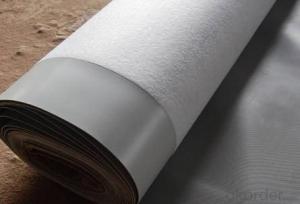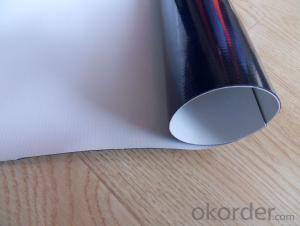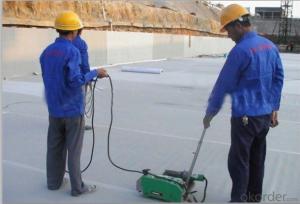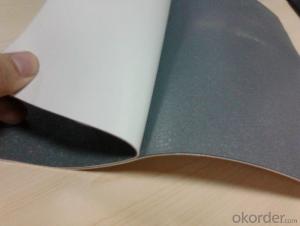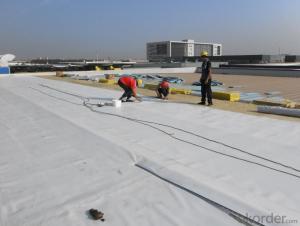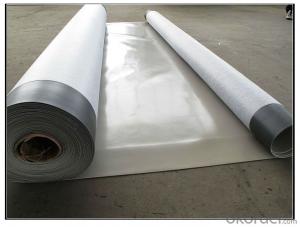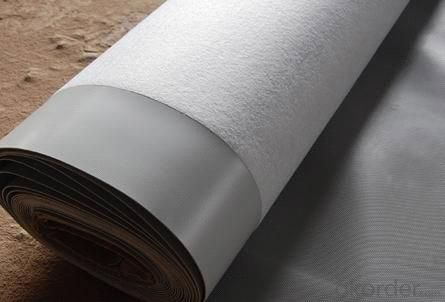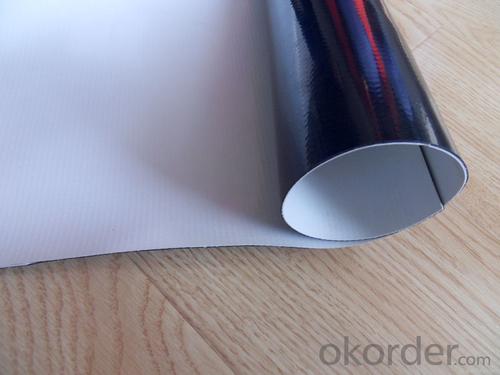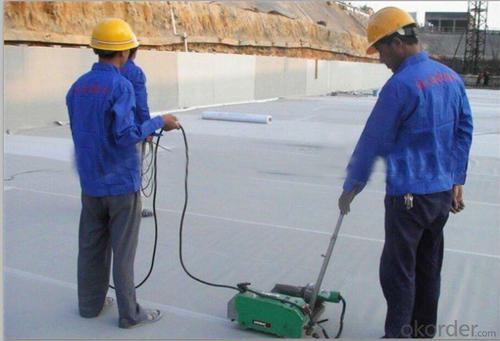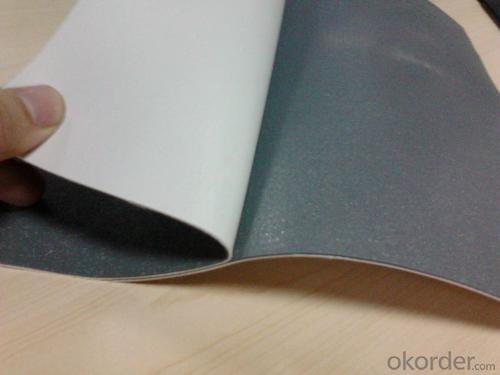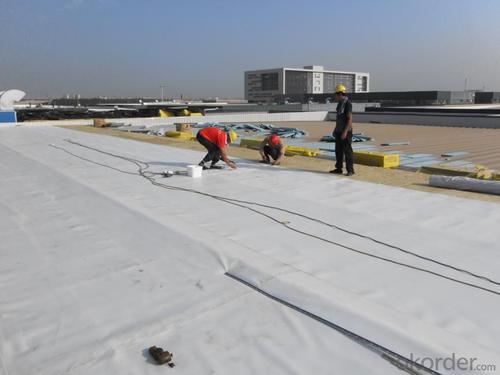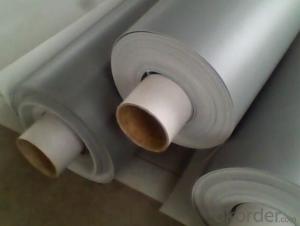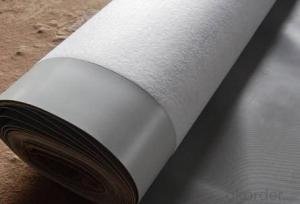PVC Waterproofing Sheets in 1.2mm with Fabric Back
- Loading Port:
- Shanghai
- Payment Terms:
- TT OR LC
- Min Order Qty:
- 20000 m²
- Supply Capability:
- 5000000 m²/month
OKorder Service Pledge
OKorder Financial Service
You Might Also Like
PVC Waterproofing Sheets in 1.2mm with Fabric Back
Product Description of PVC Waterproofing Sheets in 1.2mm with Fabric Back:
PVC Membrane Waterproof /Waterproofing membrane For Roof is a new polymer waterproof membrane. The PVC Membrane Waterproof /Waterproofing membrane For Roof raw material is polyvinyl chloride resin, mixed with plasticizer, filler, antioxygen, ultraviolet absorber and other auxiliaries.
Thickness: 1.2mm/1.5mm/1.8mm/2.0mm
Width:2050mm
Length:20m( Special specifications can be customized)
Size: 2.05mx20m
Color: white/grey, or any other colors.
Features of PVC Waterproofing Sheets in 1.2mm with Fabric Back:
1. Excellent anti-aging property.
2. Puncture- resistant.
3. Welding construction,
4. High tensile strength, good elongation, good dimensional stability.
5. Good plasticity.
6. It has self-extinguishing from fire property.
7. Materials surface is smooth, fast color, stain resistance.
8. More wide, Wastage become less when being used.
Classification of PVC Waterproofing Sheets in 1.2mm with Fabric Back:
1. N: Homogeneous PVC membrane
2. L: PVC membrane with fabric backing
3. W: Reinforced PVC membrane
Advantage of PVC Waterproofing Sheets in 1.2mm with Fabric Back:
1.) Mixing automation. Apply automatic temperature control automatic time control and automatic feed control.
2.) Extrusion equipment uses twin screw coextrusion. Screw temperature uses computer automatic temperature control system.
3.) Handpiece uses large width didhead extrusion equipment.
4.) Sophisticated three-roller calender equipment. The space between equiment is controlled by automation system.
Technical Data of PVC Waterproofing Sheets in 1.2mm with Fabric Back:
No. | Item | Model Ⅱ | |
1 | Tensile Strength Mpa ≥ | 12.0 | |
2 | Elongation at break% ≥ | 250 | |
3 | Shrinkage rate % ≤ | 2.0 | |
4 | Flexibility at low temperature | No crackle at -25oC | |
5 | Water tightness | Watertight | |
6 | Puncture resistance | Watertight | |
7 | Heat aging treatment | Appearance | Free from bubble, crack, cohesion and void |
Change rate of tensile strength % | +20oC | ||
Change rate of elongation at break | |||
Flexibility at low temperature | No crack at -20oC | ||
8 | Chemical corrosion resistance | Change rate of tensile strength % | +20 |
Change rate of elongation at break | |||
Flexibility at low temperature | No crack at -20oC | ||
9 | Artificial weathering | Change rate of tensile strength % | +20 |
Change rate of elongation at break | |||
Flexibility at low temperature | No crack at -20oC | ||
Application of PVC Waterproofing Sheets in 1.2mm with Fabric Back:
1) All kinds of roofs, such as steel structure roof, planted roof etc.
2) Underground engineering, such as building basement, subways, tunnels, air raid shelter, etc.
3) Other projects like artificial lake, dam, water reservoir, grain storehouse, etc.
Images of PVC Waterproofing Sheets in 1.2mm with Fabric Back:
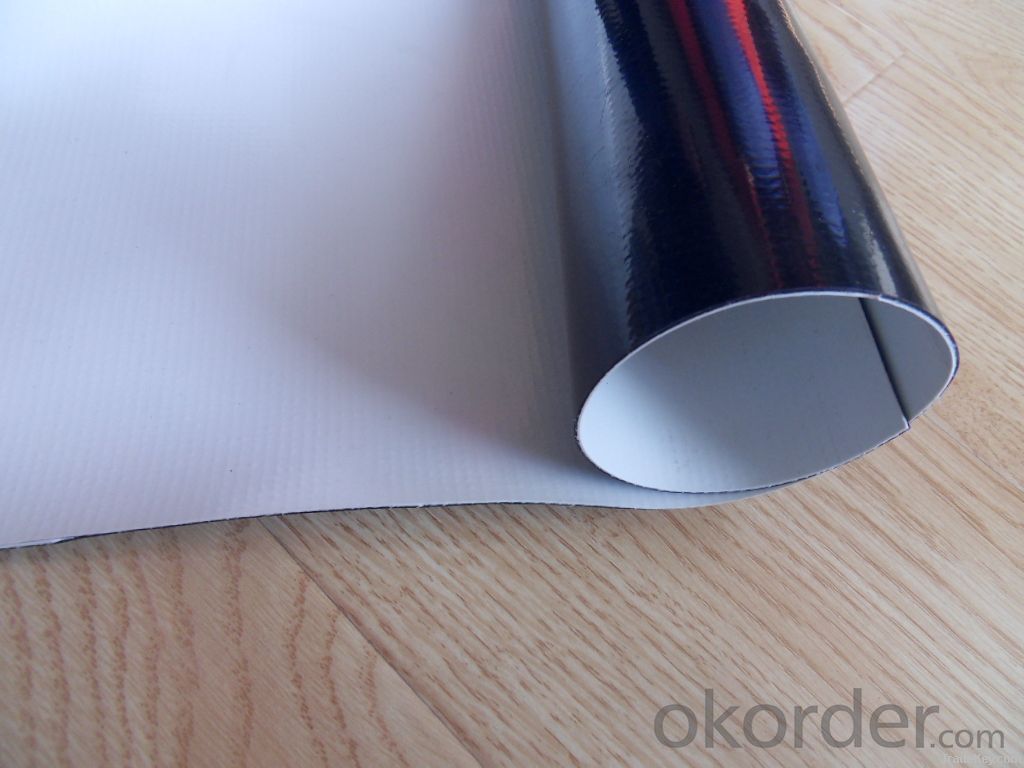
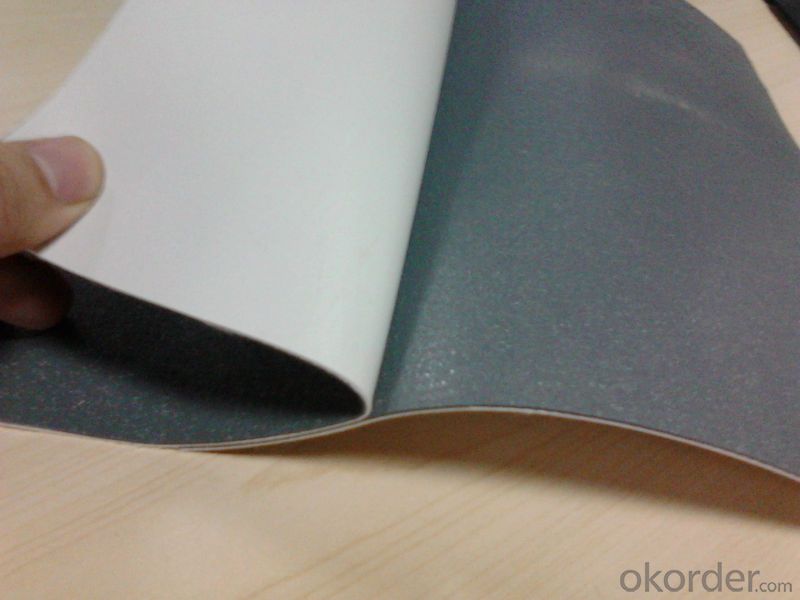
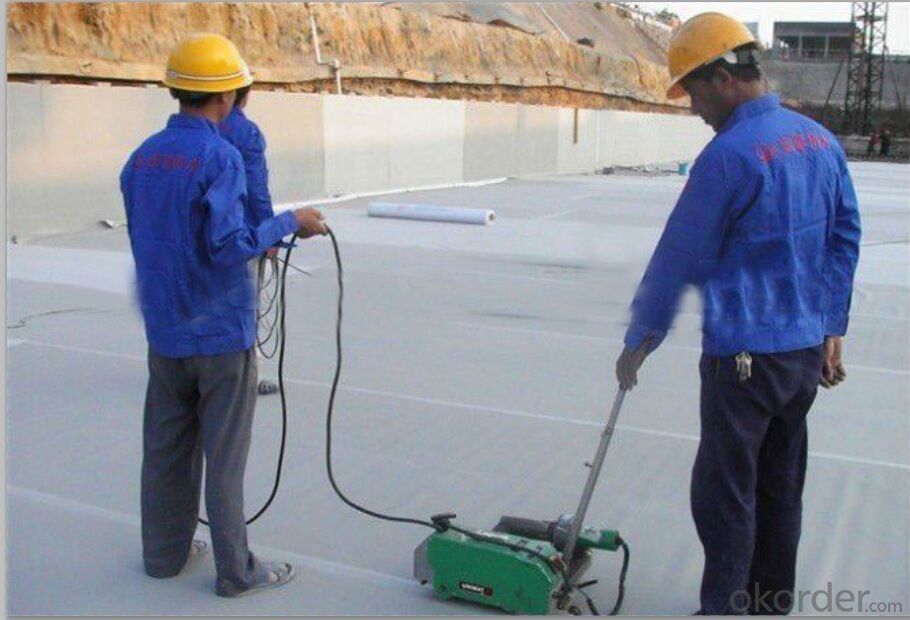
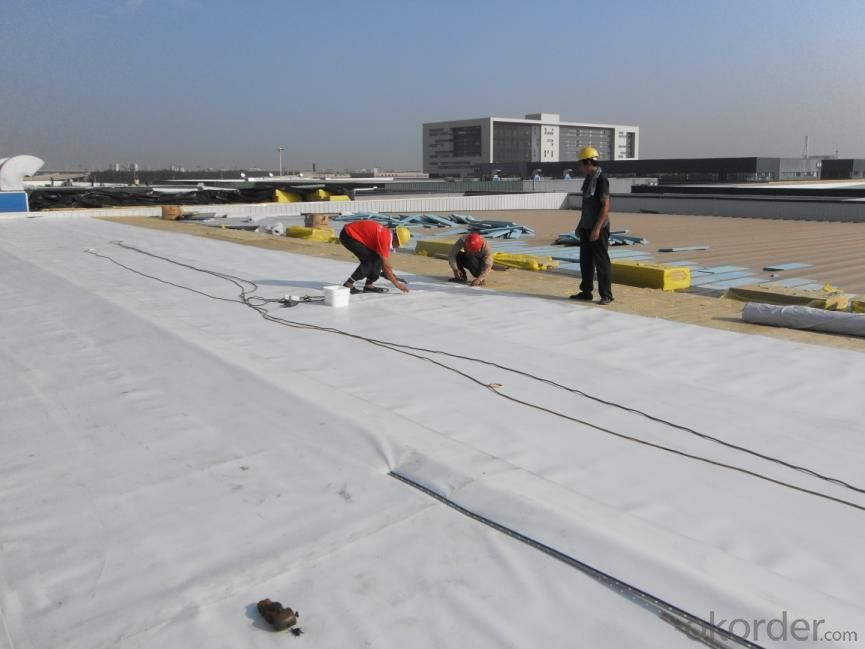
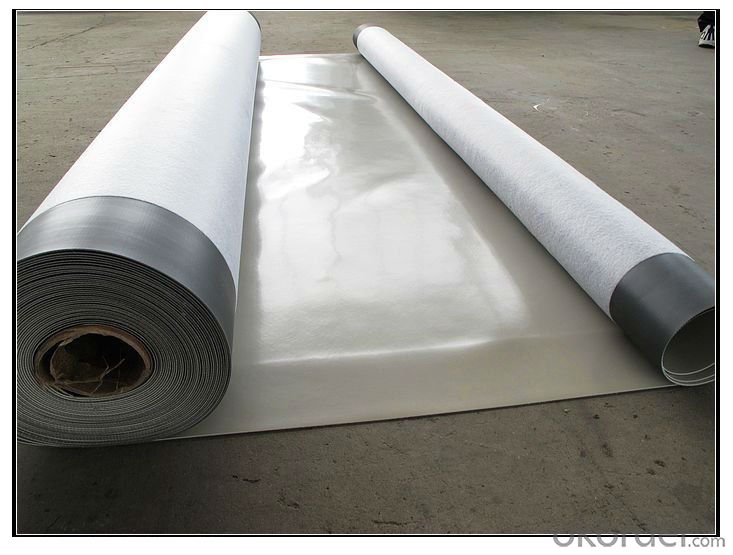
FAQ:
1. Can you produce 4m width?
Yes, no problem for us. We have four bases in China, largest one in this field.
2. How many quantity in one 20'' container for 1.2mm and 1.5mm?
480rolls, 11520m2 for 1.2mm and 400rolls, 9600m2 for 1.5mm
3. Can you provide free samples?
Yes, our samples are free, but express fees usually on buyer's account.
- Q: Can a waterproofing membrane be used for concrete tank linings?
- Yes, a waterproofing membrane can be used for concrete tank linings. A waterproofing membrane is designed to create a barrier against water penetration, which makes it suitable for protecting concrete tanks from potential leaks or moisture damage.
- Q: Can a waterproofing membrane be used on tunnels with architectural features?
- Yes, a waterproofing membrane can be used on tunnels with architectural features. The membrane can be applied to various surfaces, including those with architectural features, to provide effective waterproofing and prevent water infiltration. This ensures the protection of the tunnel structure and helps maintain its integrity.
- Q: Can a waterproofing membrane be used in conjunction with energy-efficient building designs?
- Yes, a waterproofing membrane can be used in conjunction with energy-efficient building designs. In fact, it is often recommended to have a waterproofing membrane as part of energy-efficient building designs, as it helps to protect the building from moisture infiltration and potential damage. By preventing water penetration, the membrane helps maintain the integrity of the building envelope, thus optimizing the energy performance and overall efficiency of the structure.
- Q: What is the material on the insulation layer on the waterproofing membrane?
- The isolation layer of the roof waterproof layer is generally set between the waterproof layer and the above rigid protective layer, and he has two roles. 1, the surface of the rigid layer (usually 40mm thick fine stone concrete) will have thermal expansion and contraction deformation, if the waterproof layer and the rigid layer is very good, rigid layer deformation will affect the deformation of the waterproof layer, so there may be waterproof Layer to produce a direct cracking or long-term fatigue damage, so the two tectonic layers should be set with a sliding function of the isolation layer;
- Q: Can waterproofing membranes be used on elevator pits?
- Yes, waterproofing membranes can be used on elevator pits. Elevator pits are prone to water infiltration due to their location below ground level, making them susceptible to water damage and leaks. Waterproofing membranes provide an effective solution to prevent water penetration and protect elevator pits from moisture-related issues. These membranes are designed to create a watertight barrier, usually made of materials such as rubber, polyurethane, or bitumen. They are applied to the walls and floor of the elevator pit, forming a seamless and durable protective layer. This membrane system helps to keep the pit dry, preventing water damage to the elevator components and ensuring the safe and reliable operation of the elevator.
- Q: Can a waterproofing membrane be used in new construction?
- Yes, a waterproofing membrane can be used in new construction. In fact, it is often recommended to install a waterproofing membrane during the construction phase to provide an added layer of protection against water damage. Waterproofing membranes are typically applied to the exterior foundation walls and basement floors to prevent water infiltration and to create a barrier against moisture. This can help to prevent issues such as leaks, mold, and structural damage in the future. Additionally, waterproofing membranes can also be used in other areas of a new construction project, such as roofs, balconies, and bathrooms, to ensure long-lasting waterproofing protection. Overall, using a waterproofing membrane in new construction can help to prolong the lifespan of the building and provide peace of mind for the occupants.
- Q: Can a waterproofing membrane be used on tunnels with ventilation systems?
- Yes, a waterproofing membrane can be used on tunnels with ventilation systems. In fact, it is highly recommended to use waterproofing membranes in such tunnels to prevent water infiltration and potential damage to the tunnel structure or the ventilation system. The waterproofing membrane will create a barrier that prevents water from seeping into the tunnel, ensuring its integrity and protecting the ventilation system from water-related issues such as corrosion or moisture build-up. Additionally, using a waterproofing membrane can help maintain the efficiency and effectiveness of the ventilation system by preventing moisture or water vapor from entering the tunnel and potentially causing condensation or mold growth. Overall, using a waterproofing membrane in tunnels with ventilation systems is a crucial step in ensuring the long-term durability and functionality of both the tunnel and its associated ventilation system.
- Q: Can a waterproofing membrane be used for restaurants or kitchens?
- Restaurants or kitchens can indeed utilize waterproofing membranes. These membranes are frequently employed in these spaces to safeguard the foundational structure against water damage. Generally, they are installed in areas prone to water exposure such as floors, walls, and countertops. By preventing water infiltration into the building materials, waterproofing membranes avert deterioration, mold growth, and other related problems. Furthermore, these membranes are specifically designed to resist chemicals and stains commonly found in restaurant or kitchen settings. In conclusion, the use of a waterproofing membrane is an effective means to ensure the durability and longevity of the restaurant or kitchen, while also upholding a sanitary and hygienic environment.
- Q: Can waterproofing membranes be used on below-grade parking structures?
- Yes, waterproofing membranes can be used on below-grade parking structures. In fact, they are commonly used to protect these structures from water infiltration and potential damage. Waterproofing membranes are designed to provide a barrier against water penetration, thus preventing moisture from seeping into the concrete and causing deterioration. These membranes can be applied to the below-grade walls and floors of parking structures to ensure their long-term durability and structural integrity. Additionally, waterproofing membranes can also help prevent the formation of mold and mildew, which can be a common issue in damp environments such as below-grade parking structures. Overall, using waterproofing membranes is highly recommended for below-grade parking structures to protect them from water damage and extend their lifespan.
- Q: Can a waterproofing membrane be used in areas with high groundwater levels or flooding?
- Yes, a waterproofing membrane can be used in areas with high groundwater levels or flooding. Waterproofing membranes are designed to provide a barrier against water infiltration and can effectively protect structures from water damage. These membranes are typically made of materials such as bitumen, rubber, or synthetic polymers, which are impermeable to water. They are applied on various surfaces such as foundations, basements, roofs, and walls to prevent water penetration. In areas with high groundwater levels or frequent flooding, the use of a waterproofing membrane becomes even more crucial. The membrane acts as a protective layer, preventing water from seeping into the structure and causing potential damage. It ensures that the interior of the building remains dry and free from water-related issues such as mold, mildew, and structural deterioration. However, it's important to consider the specific conditions of the site and the level of groundwater or flooding. In some extreme cases, where water pressure is high or flooding is prolonged, additional waterproofing measures may be necessary, such as installing a drainage system or using thicker and more robust membranes. Consulting with a professional waterproofing contractor or engineer is recommended to ensure the appropriate membrane system is chosen and installed correctly for the specific conditions of the site.
Send your message to us
PVC Waterproofing Sheets in 1.2mm with Fabric Back
- Loading Port:
- Shanghai
- Payment Terms:
- TT OR LC
- Min Order Qty:
- 20000 m²
- Supply Capability:
- 5000000 m²/month
OKorder Service Pledge
OKorder Financial Service
Similar products
Hot products
Hot Searches
Related keywords
